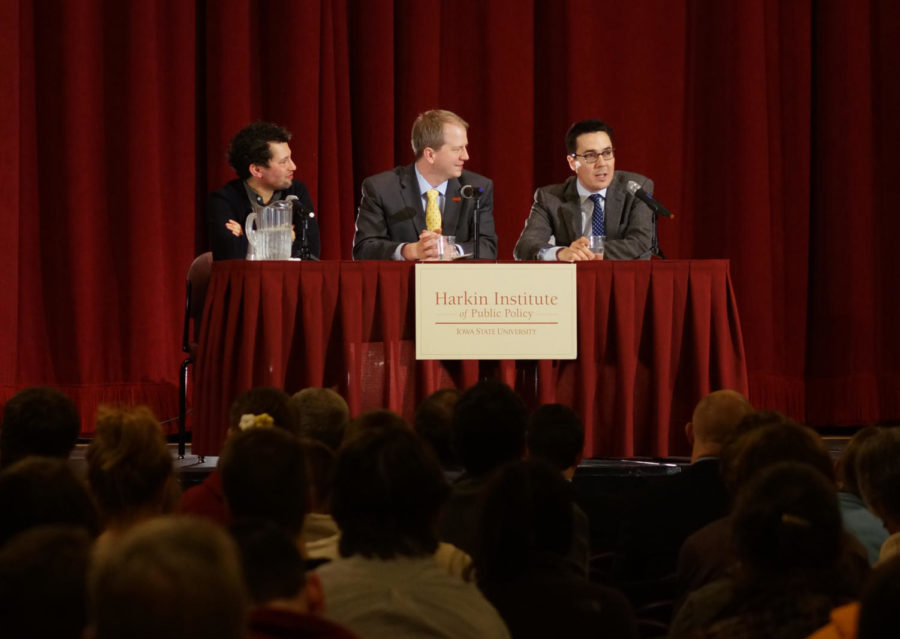Political journalists talk changes in campaign strategy
Photo: Jessica Langr/Iowa State Daily
From Left to Right: Sasha Issenberg, author of “The Victory Lab: The Secret Science of Winning Campaigns,” David Peterson, Political Science professor at Iowa State, and Ryan Lizza from the New Yorker discuss how campaigns are affected by new election styles. Issenberg is interested in integrating experiments into election campaigns and how campaigns learn from each other over time, while Lizza recognized that there was more than just a technical gap between the Right and Left parties.
February 5, 2013
The 2012 election saw not only the introduction of new campaign strategies, but also a shift in political coverage.
Political writers Ryan Lizza and Sasha Issenberg answered questions from political science professor and interim director of the Harkin Institute of Public Policy, David Peterson, concerning changes in campaign styles and coverage at a lecture on Tuesday, Feb. 4.
Lizza, a Washington correspondent for The New Yorker and a CNN contributor, explained that it is time for reporters to move past the “psychological portraits” that have been popular in political coverage for many years.
“I wondered about the limits to that approach,” Lizza said, who, along with Issenberg, explained that the use of social science is important to furthered political coverage.
Peterson explained that social science is “using scientific method to study people.”
Issenberg, who writes for Slate.com and is the author of the book The Victory Lab: The Secret Science of Winning Campaigns, said that the use of social sciences or field experiments to study elections, “starts to open up the possibility that we [journalists] can demand a higher burden of proof.”
By paying attention to what Issenberg described as the “ground game” in elections, such as polls, voter information and how campaigns are run, instead of focusing solely on covering speeches and candidate profiles, there is a greater chance for understanding why a campaign strategy is successful.
Both Lizza and Issenberg touched on the point that journalists sometimes make claims as to why something happened without having the evidence to back it up.
With field experiments taking place within campaign organizations and from political scientists on the outside, there is now data accessible to journalists.
“There are more people who are aware of social science techniques and how to use them,” Lizza explained, also pointing out that some of this comes from political scientists who have “climbed down from their ivory towers,” and are having more open conversations on such topics.
Lizza and Issenberg also addressed the idea that the Republican Party has more catching up to do when it comes to using social science in their campaigns and conducting field experiments to discover which strategies work and which don’t.
“Organizing as an idea, the history on the left is much more interested,” Lizza said of the democrat’s stronger interest in studying the “ground game” factors of a campaign.
Finding the answer to what matters in campaigns, and what does not, is one question that Lizza said may be focused on in the future, pointing specifically to what types of messages work in political advertising.
Issenberg would like to see a stronger understanding of roles between political scientists and journalists in the future, and both spoke of continued use of social sciences in studying campaigns.
“What all these studies show works right now, does not mean they’ll work tomorrow,” Lizza said.
There were approximately 240 people at the lecture, “How New Campaign Styles Win Elections.” The lecture was part of the day-long Symposium on social science, political campaigns and political reporting.

















